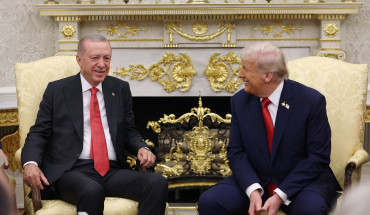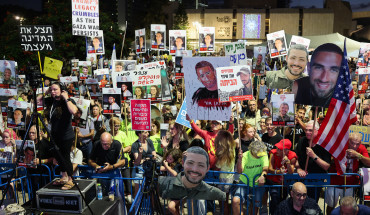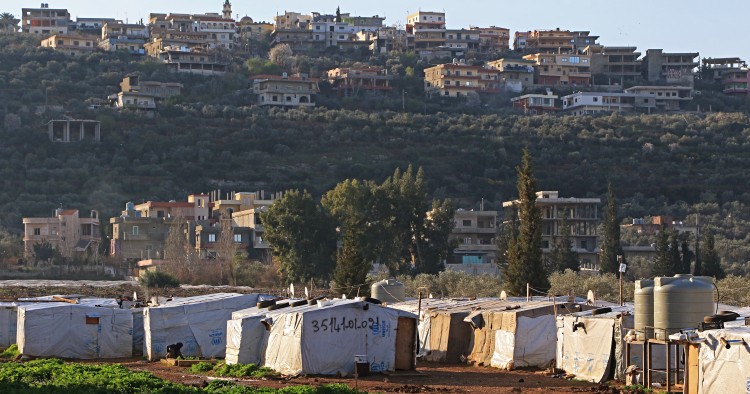This essay is part of a series that explores the human costs and policy challenges associated with forced displacement crises in the Middle East and Asia. The essays explore the myths or misconceptions that have pervaded discussions about these crises, as well as the constraints or capacity deficiencies that have hampered the responses to them. See more ...
In recent years, the burden that refugees are believed to place on host societies has drawn a great deal of international attention.[1] However, the social class systems that underlie crisis-affected settings and crisis management itself remain a taboo in international debates and humanitarian programming.
Nowadays there are many criticisms of humanitarianism being politically neutral, arbitrarily universal, or often lacking in context relevance. Indeed, global humanitarian action largely originated from a condition of inequality and traditionally has been articulated accordingly — juxtaposing those who suffer and who need protection, and those who act with compassion and protect those in need. As Miriam Ticktin pointed out, “humanitarianism began as a moral, racialized, and religious ordering; it was not an egalitarian project, despite the belief in shared suffering.”[2]
Due to the protracted duration of most emergencies, international humanitarian agencies mobilizing to offer shelter and assistance to the displaced populations gradually acknowledged the need to extend their programs to “host” populations, and to therefore develop a better understanding of specific contexts. This led non-governmental organization (NGO) practitioners, scholars, and researchers to assess the social, political, and economic impact of humanitarian programs in targeted areas. According to these impact assessments, humanitarian programs have, at times, appeared to exacerbate local inequalities. Scholars have similarly critiqued humanitarianism for having overlooked preexisting (i.e., pre-crisis) inequalities.[3]
Yet, little attention has been paid to the class-based inequality that the very presence of humanitarian agencies produces in crisis-affected settings. In such settings, there exists a class economy composed of foreign aid practitioners, the receiving country’s citizens, and migrants — representing different economic backgrounds when accessing services and goods, and using local infrastructures. Refugee groups themselves are normally variegated along social class lines, though such differences are often made invisible given the tendency to homogenize refugee profiles and backgrounds. Whereas the numbers of refugees and the money allocated to respond to humanitarian crises are generally well known and publicly discussed, information on the number of humanitarian workers employed, recruitment policies, and private belongings at stake is more difficult to access. In a nutshell, we can easily find out what humanitarian practices are about, but not who performs them.
In other words, although aid workers are consumers and users of local economies to the same extent as local residents and migrants in crisis-affected settings, their social and economic presence has received little scrutiny. Commentators have discussed the gentrification of the areas targeted by humanitarians, the way in which humanitarianism tends to neglect chronic vulnerabilities, or exacerbate the center-periphery dynamics of host cities.[4] However, they have made little reference to social class. This omission is a symptom of how discussions around humanitarianism have (not too innocently) neglected the social class dimension. The importance of class struggle in humanitarian spaces has therefore been overshadowed in the mainstream humanitarian narrative, in which human life is reduced to a (class-less) biological continuation of societies.[5]
Among today’s several humanitarian debates revolving around self-reliance, sustainability, and accountability, the international attention on humanitarian interventions in urban settings stands out. Cities are commonly regarded as the primary places where class economies become layered and articulated; however, the debates on “urban humanitarianism” have likewise neglected social class as a key factor that significantly marks the relationship between aid providers and recipients in settings of aid provision. The small city of Halba, in northern Lebanon, vividly illustrates how the class economy has tacitly been shaping humanitarian programming and how the very presence of humanitarian actors on the ground reinforced the pre-existing class-based inequality.
The Economy of Lebanon’s Halba
Halba is located in Akkar, one of Lebanon’s most deprived regions. According to the local municipality’s estimates collected in March 2017, Halba’s population at the time consisted of 27,000 local inhabitants and 17,000 refugees. In this peri-urban landscape, where physical boundaries are difficult to identify as they merge with rural surroundings, Syrian refugees mostly reside in informal gatherings on pieces of land at the side of public roads or, in other cases, rent out private apartments. The small city forms a commercial and administrative hub for the surrounding hamlets.
During the 1975–1990 Lebanese civil war, Halba became an employment hub, as many dwellers of Tripoli — the largest northern Lebanese city — faced everyday violence and destruction and therefore resettled to nearby Akkar. Halba's economic importance derived from its location between Syria’s Homs and Tripoli and from being the main market for the surrounding villages.[6] However, as local residents emphasized to me during several conversations between March 2017 and January 2019, the local market and the public square have disappeared because of the lack of urban planning.
After 1975 especially, Halba turned from a large village, mostly based on agriculture, to a “city with no order,”[7] characterized by uncontrolled growth and peri-urban poverty. During the 1980s, unauthorized houses emerged in Halba’s surrounding fields where there used to be cotton cultivations, thus reducing the size of cultivable areas.Infrastructure and services are insufficient. Electricity, when not purchased privately, is only available for a few hours per day. The rapid urbanization of Halba has therefore offered few economic opportunities, but rather competition over resources and jobs across similar social strata. This has happened because Halba has not been developed as a city.[8]
Northern Lebanon after the Syrian crisis: Beyond Benefits and Burdens
In northern Lebanon, several INGOs now develop their programs by building on the urban-humanitarian nexus. However, the international tendency to ignore the local class system and humanitarianism as a specifically classed project dies hard. Yet, if Akkar is a historically forgotten area (often self-baptized as manta’a yatime, a regional “orphan” of its own central state), the impact of sudden demographic growth and humanitarian presence vary considerably according to social class.
With the arrival of foreign humanitarian agencies responding to the Syrian refugee crisis from 2012 onward, locals who were better-off have become wealthier as they have relied on the increasingly lower costs of the available Syrian workforce. (Historically, the latter constitute the working class made up of constructors, painters, and peasants, along with the local poor). On the one hand, international and local aid workers who reside in the area have potentially created demand for a new market, while not forming themselves a homogeneous social class (i.e. local staff normally enjoy lower pay scales than the internationals). Owners of properties and rental agents have witnessed greater international investment since humanitarian agencies are used to renting cars, staff, and apartments when deployed in the field. On the other, poorer classes have felt most of the economic pressure following the arrival of Syrian refugees and the consequent influx of cheap menial labor. Major pressure was perceived in the agricultural sector. The socio-economic impacts of Syrian refugees and of the humanitarian presence in Akkar, hence, emerge as context-sensitive and layered.
With no intent to undercut Lebanon’s infrastructural predicament during the Syrian crisis, local institutions and infrastructure, to a certain extent, gained greater income with the presence of new Syrian components in the region.[9] In-hospital births are a clear example: Syrian refugees benefit from United Nations High Commission for Refugees (UNHCR) financial support in order to deliver babies in public hospitals (UNHCR does not cover private services). The UN agency, however, pays up to 80% of the health service provided and only in cases of non-chronic illness. On a quantitative level, this means that Syrian nationals who deliver their babies in one of the hospitals included on the UNHCR list, still need to pay 200,000 to 250,000 Lebanese Lira (150 USD) to access assistance during birth.[10]
Similarly, the opening of job positions for aid workers allowed educated local youths to become employed. Indeed, during my visits, many local aid workers in Halba confirmed they were unemployed before taking up NGO positions, which flourished with the arrival of external funding, especially until 2016. This, however, generated temporary empowerment of local middle classes, which remain at the mercy of crisis-driven labor and, more broadly, of geopolitical interests. On the same note, the World Food Program (WFP) and UNHCR, by providing food vouchers and later e-cards to Syrian refugees in the region, mostly enriched large shops and wealthy shop owners. This eventually affected the smaller shops, as anguished local residents often voiced to me.
However, some of these new profitable factors, which could have made this region more resourceful, turned out to be unsteady throughout the protracted Syrian displacement. For instance, aid work positions within the local economy of labor were short-lived. The period of high demand for skilled and professional labor — unprecedented in Akkar before 2012 — recently ended as a result of the enforcement of tougher labor measures. Demand for international skilled workers has likewise plummeted due to the decreasing funding allocated to the Syrian humanitarian crisis. Overall, the daily narrative of generalized deprivation in Lebanon had the problematic effect of ironing out diverse economic vulnerabilities as well as wealth and exploitation in the local class economy.
The Hidden Role of Social Class
Against this backdrop, the humanitarian economy of consumerism and labor has not brought durable benefits to Akkar. The arrival of humanitarian agencies has not transformed Halba from an administrative hub into a consumption city. Despite an unprecedented humanitarian presence due to the Syrian crisis, the overall market demand has barely increased. As a local resident argued,[11] at the beginning of the refugee influx many residents opened new shops, but they eventually shut down as the rent was expensive and customers were few. Similarly, the resources needed for the functioning of the humanitarian system were largely outsourced. By the same token, international newcomers — mostly from 2012 to 2015 — seldom frequented Halba for entertainment and consumption purposes. Due to the strict politics of work permits and recent NGO employment policies, which follow tougher national measures also towards upper and middle classes migration labor, Lebanese nationals now apparently make up 90% of INGO and local NGO staff.[12] Moreover, most local and international NGO practitioners who work in Halba live in Tripoli, or in the nearby village of al-Qobaiyat, which is comparatively wealthier. “In Qobaiyat people can find alcohol more easily and there are more cafes and restaurants. We don’t enhance the business volume in Halba, which remains a place for peasants; we go elsewhere for shopping,” recounted a local aid worker.[13]
The character of Halba’s economy is hard to capture due to the scarcity of quantitative data. “Halba has direct contact with international humanitarian organizations and that is an asset as it gets more resources than hamlets,” noticed Halba’s governor.[14] Likewise, the Syrian refugees who reside in Halba are considered wealthier than the refugees who opt for rural life. In this regard, an aid worker affirmed, “We don’t have many projects in Halba, because the refugees in this city are generally less vulnerable. They used to live in cities inside Syria, representing advantaged classes and providing skilled work.”[15] Even though I do not have access to statistics, my interviews with refugees showed that many of them are from rural backgrounds; and their livelihoods seemed to be no more sustainable than those of people living in rural surroundings.
The burden placed on Akkar’s poor infrastructure as a result of the demographic growth spurred by the Syrian refugee influx has further impacted the local class divide. However, the presence of Syrian refugees does certainly not explain it all. The number of international aid workers populating northern Lebanon, in particular between 2012 and 2015, is never mentioned in local and regional economic assessments and official statistics. Foreign humanitarian workers were not counted as part of the labor and class economy, partly in a bid to conceal the local presence of educated people who would have been able to take up the same job positions — an issue which the Lebanese government purportedly intended to address recently in the effort to curb local unemployment.[16] Nor are foreign humanitarian workers mentioned as local consumers who also access resources and put a strain on local infrastructure. This is because of the more generous purchasing power that international aid workers generally dispose of in deprived regions and their higher socio-economic status within Lebanese society.[17] Similarly, class differences tacitly determine discussions about the (il)legal status of non-Lebanese: governments and political commentators shed light on the illegal status of refugees, while ignoring the illegal status of many international aid practitioners working in the Syria neighborhood because, unlike the refugees — who are all indiscriminately believed to be ‘poor’ — they represent the middle and upper classes within host societies.
Social Class as a Humanitarian Taboo
Along the same lines, economic inequality is omitted in the history of human displacement and relief efforts while the philanthropic spirit of the better-off sticks out. A suitable reminder here is the analogous tendency to remove the transnational slave trade and African diasporas from the history of forced migrations, as these were running parallel with global capitalism and European colonial rule. As a result, international humanitarianism acknowledges forced migrants not only when produced by conflicts loaded with special geopolitical relevance,[18] but also makes sure they keep their place among the local poor. In this sense, while several forms of Lebanese nationhood have surely emerged at different class levels over history, poverty has increasingly been ethnicized, criminalized and securitized during the so-called “Syrian refugee crisis” in Lebanon: anti-Syrian curfews and the use of motorbikes became the public markers of refugee delinquency rather than markers of unwanted enlarged poverty in some villages.[19]
Refugees who have historically formed Akkar’s cheap workforce are hardly distinguishable from the local poor, while increasingly being left to fend for themselves the further we get from when the crisis started. There is already a real risk that Syrian prolonged displacement turns to abandonment and this is predictably harmful.[20] This abandonment will further blur the living conditions of the local poor and those of the refugees. In this context, crisis as a problem and humanitarianism as a solution rather sustain the specter of social class. The hidden role that social class plays in settings and discourses of forced migration and global aid work should be acknowledged. On this basis, humanitarian assessments should ponder not only the consequences of aid programs but also the very presence of aid workers in the targeted areas and their relational history with local classes. By averting such self-reflection, humanitarian assessment reports will never be able to offer genuine lessons to either practitioners or scholars.
There have by now been numerous efforts towards accepting and even welcoming the political, and not only biological, survival of displaced populations. Social class is a core part of such politics: the rich-poor divide fed to different measures by the humanitarian presence in host societies should also be brought into debates and questioned in international summits and NGO programming. However, as the Lebanese intellectual and activist Bassem Chit argued, we are cognizant that this can hardly be done “through delusions based on the hope that some bourgeois apparatus might carry us to a better tomorrow.”[21] The current Lebanon uprisings will reveal the nature (and maybe the end) of such delusions.
Note: This research has been conducted in the framework of the project “Analysing South-South Humanitarian Responses to Displacement from Syria: Views from Lebanon, Jordan and Turkey,” funded by the European Research Council under the Horizon 2020 Research and Innovation agreement no. 715582.
[1] Theresia Sarkis, “Lebanon is struggling to cope with Syrian refugees, but young people are pushing the country to be positive,” The Independent, April 15, 2019, https://www.independent.co.uk/voices/syria-refugees-lebanon-youth-brussels-middle-east-a8870416.html.
[2] Miriam Ticktin, “Humanity as Concept and Method: Reconciling Critical Scholarship and Empathetic Methods,” Comparative Studies of South Asia, Africa and the Middle East 37, 3 (2017): 608-613.
[3] Didier Fassin, Life: A Critical User’s Manual (New York: Polity, 2018).
[4] See Joely Thomas and Birte Vogel, “Intervention Gentrification and Everyday Socio-economic Transactions in Intervention Societies,” Civil Wars 20, 2 (2018): 217-237.
[5] Claude Dubar and Salim Nasr, Les classes sociales au Liban (Paris: Les Presses de Sciences Po, 1976).
[6] Faraj T. Zakhour, Halba fy nisf qarn 1900-1950 (Halba: Dar Zakhour li’l tab‘a, an-nashr, wa at-tawzi‘, 2005) 24.
[7] Remark by local intellectual, February 2017.
[8] Estella Carpi and Camillo Boano, “Humanitarianism in an Urban Lebanese Setting: Missed Opportunities,” The Legal Agenda, February 5, 2018, https://www.legal-agenda.com/en/article.php?id=4211.
[9] Hisham Ashkar, “Benefiting from a Crisis: Lebanese Upscale Real-Estate Industry and the War in Syria,” Confluences Méditerranée 1, 92 (2015): 89-100, https://www.cairn.info/revue-confluences-mediterranee-2015-1-page-89.htm#.
[10] Interview with Syrian refugee women in Bebnin, spring 2017.
[11] Conversation with the author. Halba, winter 2019.
[12] United Nations Organization for the Coordination of Humanitarian Affairs (OCHA), Lebanon Humanitarian Bulletin, Issue 32 (May 1 – July 31, 2018), https://reliefweb.int/sites/reliefweb.int/files/resources/OCHA-Humanitarian%20Bulletin-Issue32-31July2018_EN_0.pdf.
[13] Interview, February 2017.
[14] Interview, March 2017.
[15] Interview, March 2018.
[16] Interview with politician in Tripoli, May 2019.
[17] Peter Redfield, “The Unbearable Lightness of Ex-Pats: Double Binds of Humanitarian Mobility,” Cultural Anthropology 27, 2 (2012): 358-382.
[18] Danilo Zolo, Invoking Humanity: War, Law and Global Order (New York: Continuum, 2002).
[19] Estella Carpi, Mariam Younes, and Marie-Noëlle AbiYaghi, “Crisis and Control: (In)Formal Hybrid Security in Lebanon,” Lebanon Support and ALNAP, January 1, 2016, https://www.alnap.org/help-library/crisis-control-informal-hybrid-security-in-lebanon.
[20] Dorothea Hillhorst, “Classical humanitarianism and resilience humanitarianism: making sense of two brands of humanitarian action,” Journal of International Humanitarian Action 3, 15 (2018), https://jhumanitarianaction.springeropen.com/track/pdf/10.1186/s41018-018-0043-6.
[21] Bassam Chit, “Nationalism, Resistance and Revolution,” International Socialism 2, 145 (January 2014): 99-118, https://www.marxists.org/history/etol/writers/chit/2014/01/nationalism.html.
The Middle East Institute (MEI) is an independent, non-partisan, non-for-profit, educational organization. It does not engage in advocacy and its scholars’ opinions are their own. MEI welcomes financial donations, but retains sole editorial control over its work and its publications reflect only the authors’ views. For a listing of MEI donors, please click here.













